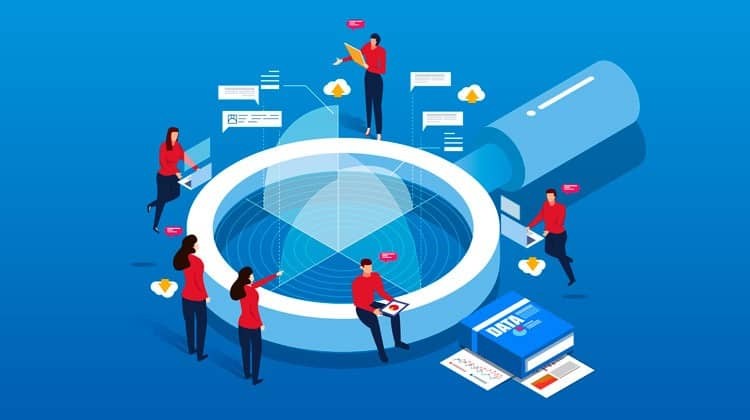by Cydney Hatch • July 27, 2018
Business to Business Advertising: Changing the Conversation
“If you aim at nothing, you will hit it every time.”
–Zig Ziglar
Oh Zig, you advertising genius.
It’s true, if you don’t take the time to get to know your customers and identify your buyer personas, you will have no idea who you need to advertise to. Business to business advertising is all about getting your target market to pay attention to your business in the hopes that they’ll buy something from you.
While many of the principles from the “Mad Men” era still apply today, to really succeed at business to business advertising, you need to know how to apply those principles in a digital world.

Some B2B marketers shy away from digital advertising because things like paid search and social media ads may seem to have been created for B2C companies. Don’t get caught up in this and get left behind… As Don Draper once said,
“If you don’t like what’s being said, change the conversation.”
B2B is evolving and many brands are successfully using digital advertising to push their B2B businesses to new heights! They are the ones changing the conversation!
So, how can your business reap the benefits and create a strong advertising plan?
In this article, we will discuss important business to business advertising strategies you can use to improve your B2B service offerings but also stir up some more sales.
Business to Business Advertising: Changing the Conversation
There are a lot of different ways to do business to business advertising online. Let’s take a look at some of the more popular options:
Paid Search
Search advertising, also known as paid search and search engine marketing (SEM), refers to online ads that appear in search engine results on platforms like Google AdWords or Bing Ads.
So, when a person uses a search engine to look up a certain product or service, search advertisements are the ones that will appear in the top areas of your Google or Bing search.
For example, if I wanted to look up a B2B accounting software on Google, this is what I get:
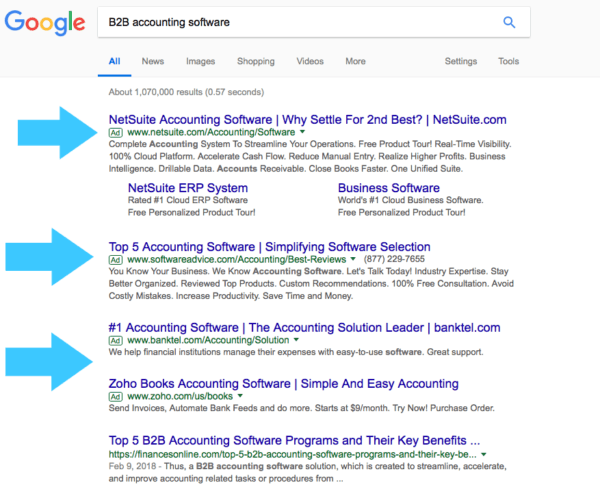
This is what the same search would get me on Bing:
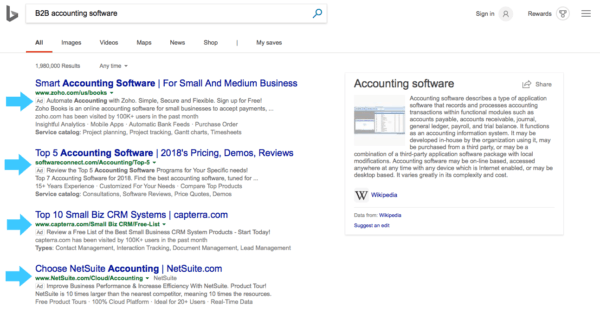
As you can see, paid search advertising is a great way to get your ads in front of an audience that is actively looking for solutions! You are advertising/marketing to people with the intent to purchase resources, services and products.
So, in the example above, these ads offer an easy solution for my accounting software needs! Yay for business pain point solutions! This is a great way to advertise because you’re giving the potential customer services they want.
This leads to high conversion rates and value.

In a nutshell, paid search advertising is the art of ensuring that when your target audience searches online…they find you.
Paid Social
Social advertising or paid social ads are advertisements that appear on social media platforms. Social media platforms like Twitter, Facebook and Instagram are paid to promote a business through boosted posts, offers and promotions.
Social ads help you target potential customers by personal, professional, demographic and behavioral parameters which allow you to reach the people who are most relevant instead of just buyer intent!
An example of this would be a sponsored Facebook post that is used to increase the posts presence or an Instagram advertisement:
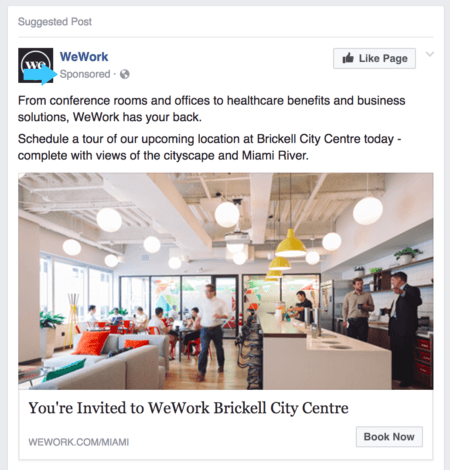
Using paid social advertisements, you are able to use effective targeting, call to action buttons, useful tracking and analytics to get fast results on relevant platforms everyone uses daily!
Display Advertising
Display ads are the ad boxes that are on the tops or sides of a website. Display ads are the billboards of the online world. They can be traditional banner ads or even videos.
For example, many news websites are full of video ads and clickable banner ads that are even that much more aggressive making you watch five seconds of a video before you can get into the content you came for.

Display advertisements allow you to run ads on millions of websites on Google’s Display Network (or other display networks like it, if Google’s not working for you). These search engines share your ads to websites and apps based on keywords targeting preferences (hopefully, your keywords are more complex than just “business” or “B2B”).
Display advertising is a lot like a digital billboard and there are a couple of ways to pay for it:
Cost per thousand impressions (CPM)
With this model, you pay to have your ad load in front of people a certain number of times. Every time your ad loads, it makes an impression, so paying for impressions is called a cost per impression advertising model. Since display ad impressions rarely lead to clicks and conversions, most advertising platforms charge a cost-per-thousand-impressions (CPM).
Fixed cost
Fixed cost is when you set a specific amount you are willing to pay for your ad to be displayed for a period of time, regardless of engagement. Usually, these are created through network partners who will run your ads across a range of websites, based on your targeting.
Native Advertising
Native advertising is paid content that is shared on a publication site that aligns with a business’s established style and provides the kind of information that the site’s audience wants. So if you are a B2B business that helps accountants your native advertising content might appear on “Accounting Today’s” website.
For example, Forbes shared a articles talking about Instagram Influencers:
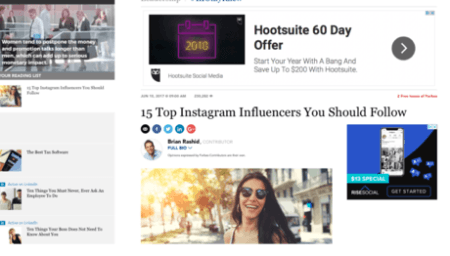
Does Forbes contain native advertising? Absolutely!
The page, obviously targeting Instagrammers, has ads portraying B2B businesses that will help you build your social media following like RiseSocial and Hootsuite!
Digital Advertising Campaign Elements
In addition to the main internet advertising channels we discussed above, there are several key campaign elements you’ll want to get right as you start advertising online.
Email Marketing
Email marketing is when a business sends some type of targeted email to a purchased lead list or a customer list. When a customer purchases a product or service online, they may offer the company their email address as a way to contact them with future deals and information.
Emails like these can encourage all kinds of customer actions: buying products, redeeming special offers, reading interesting content, interacting with a page on social media or completing a survey are only a few of the limitless possibilities. These emails can be newsletters, promotional emails, appreciations, or even content downloads.
For a lot of B2B businesses, email marketing is not necessarily going to be key for generating new business but for referrals, cultivation, and education.
Email marketing is the cheapest form of online business to business advertising as it is essentially free to complement other digital marketing efforts. All you usually have to pay for is some sort of email marketing services like MailChimp, HubSpot or Autopilot.

Keeping up with your customers via email is cost-effective, instantaneous and reduces paper waste. What’s more, there is evidence that email marketing can provide a much higher return on investment than direct mail.
Video Advertisements
Visuals, particularly videos, are the key to marketing success in today’s world. In fact, 25% of Instagram’s advertisements are now in video format.
A strong example of engaging, creative and personable advertisements if Facebook’s “Connection” video, which beautifully portrays the human need for connection and explains how Facebook solves the problem of connecting with other people.
Like them, you can create video content like this that connects people and their pain points to your B2B solutions. With 65% of the population claiming to be visual learners, brief and engaging content is what buyers will be looking for.
Videos, which are easy to share, are a great way to incorporate your brand’s story through an engaging set of visuals. In most cases, for B2B companies, an explainer video is what will work best! Look for ways to creatively advertise and share brand awareness of your B2B business
Marketing Analytics
Advertising is not left to chance for magical success You should track how ads are performing and where their traffic is coming from. This is why analytics is an important part of internet advertising strategy.
Using marketing analytics, you can examine your audience demographics, impressions, click through rates, cost per conversion and many other trends over a set of time.
Using these insights, analytics and responses allows you to work smarter, not harder. This information helps you tweak future ads and marketing to be better. If something isn’t working, you can change it. If something is working, you can figure out how to continue advancing and promoting that idea with more money and resources.
Content Marketing
There are a lot of studies out there that have established that publishing a consistent amount of content a month can considerably raise your website traffic! In fact, companies that published 16+ blog posts per month got almost 3.5X more traffic than companies that published between 0-4 monthly posts.

Content marketing—whether that be blogging, whitepapers, eBooks or podcasts—really works if you do it correctly. Each time you publish engaging content, you’re creating a new opportunity to get found on search engines, social media and by new potential clients.
Now, before you feel overwhelmed thinking you need to write novels of meaningful content, know that effective B2B content marking is not a matter of writing a 200-word blog post a few times a week or posting a beautifully made video campaign someone else put together.
B2B content marketing is about giving potential customers value, information and a reason to choose you. Whether that is sharing helpful information, creating entertainment, or developing a “community” that helps them feel apart of something “bigger,” content should give people value. If you do that, potential customers will want to invest and engage with you.
If you struggle to think about what to write about start to brainstorm topics relating to your B2B business. For example, if I owned a B2B Furniture business, I could start brainstorming a list of relevant topics and questions for my blog/posts like:
- Statistics About Time Spent At the Office in 2018 & Why Quality Office Spaces are Important
- Comparing and Understanding Furniture Plans
- Tips and Tricks for Office Space Use
- FAQ
- What are Effective Office Designs and Why
- How An Organized Desk is Better For Your Health and Tips
- How Open and Minimalistic Office Spaces are on the Rage
- How to Make a Good First Impression in Your Office Space
Offering meaningful resources in your business to business advertising will bring more people to your website. With content marketing, you can bring in people who are more likely to need your services at some point since they are already looking for resources on similar topics.
Mobile Optimization
18-34-year-olds account for almost half of all researchers/buyers. If you’re not advertising to this group, you need to reevaluate your strategy. It’s important to take into account your Millennial audience’s familiarity with digital and how this influences the kind of content and media channels you will be utilizing.

According to Google’s recent report, “The Changing Face of B2B Marketing,” 42% of B2B customers use mobile devices during their purchasing process. This means that you need to utilize mobile experiences throughout the whole purchasing process!
How can you do this? I suggest the following:
- Create websites designed for smaller screens
- Choose platforms that are mobile-optimized so customers can have a consistent shopping experience
- Provide social media video content to promote sales, promos and events
- Use social media advertisements heavily for content promotion and business branding
- Increase the visibility and seamlessness of sales and promotions across your various digital channels
Businesses that want to succeed need to optimize for mobile in all of their advertising efforts. It takes a little extra work, but the results are worth it.
Remarketing
Ever browse through a website, click out the tab and later see ads featuring some of the items you were browsing? If so, you have been remarketed to!

Remarketing has become one of the most important tools in a digital marketer’s toolbox as it helps people move towards final purchasing. Remarketing allows you to track users who have interacted with your website or brand without a purchase or action and shares your ads on other websites.
Think of this as the ultimate digital stalking, products will stay on your mind and follow you! Remarking strategy increases brand awareness and usually helps with conversion!
Landing Pages
Landing pages are web pages that a person is taken to after clicking on an ad. Landing pages are separate from your website and are designed to only receive campaign traffic.
Now, these might be confused with a website homepage, but do not make the mistake of linking an internet advertising campaign to your homepage! Your homepage is designed for people to explore your brand and has link toolbars to navigation other areas of your site. It’s designed for website viewing, not targeted action.
For example, Career Arc, a technology-based social recruiting and outplacement solutions to help HR leaders, has a landing page and a website that are consistent with their brand and easy to use.
Their landing page asks for a viewer to sign up to read about a 2015 Workplace Flexibility Study. It has a specific call to action and strategically collected information for further use. It is visually informative and simple so this is a wonderful example of a successful landing page.
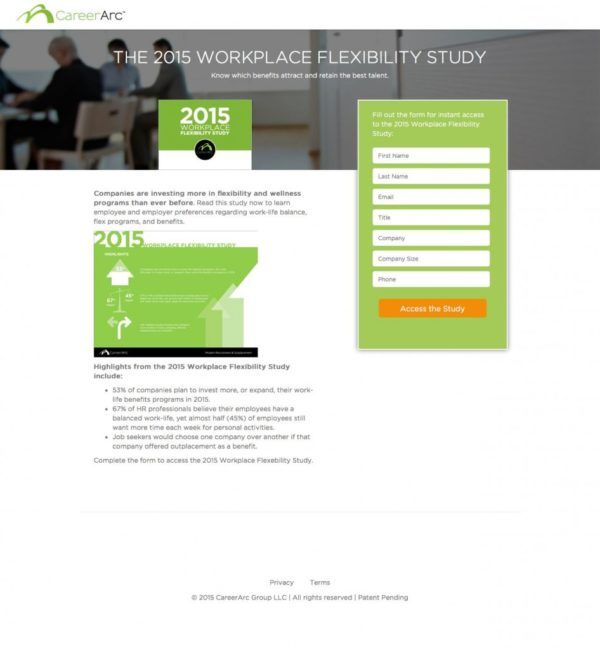
This landing page differs from their website homepage below, which is a general experience for a viewer to explore and engage with their B2B business.
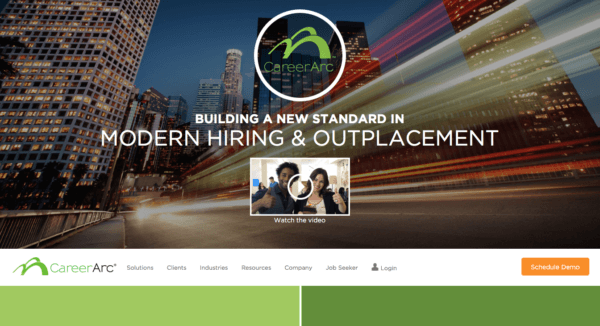
Your landing pages are designed for one purpose only: results! These results can be making a purchase, getting contact info from potential clients or downloading a piece of content for future leads.

Digital A/B Testing
Analytics software not only provides your B2B business with vital feedback, it also allows you to test variations on your advertisements and landing pages so that you can improve them.
For example, you can test if a banner ad does better in one visual way or another.
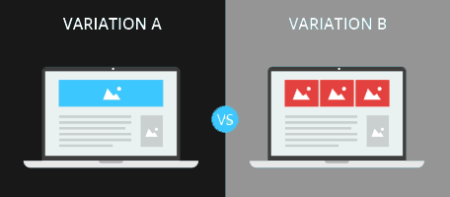
This is not a guessing game, though, and if you treat it like one, you will be missing out on advertising success.
In a situation like this, you can set up what’s called an A/B test. You make both versions of the banner and then half of the people who click your ad are sent to one version and the other half are sent to the other.
What does this do?
Well, it teaches you which one is doing better and you can learn more about what your target audience wants/prefers. You should do this frequently in month spans to refine your content and visual advertisements for optimal success.
Business to Business Advertising: You Can Do It!
The above essentials are key strategies to consider when looking to expand your business to business advertising efforts. Dive in, set up a business plan, get creative, build meaningful relationships and enjoy the digital advertising of today!
Conversations are changing and the opportunities and level for success are endless! You too can be apart of the digital advertising world and be a key speaker in the conversation using these business to business advertising strategies!

By the way, if you’d like help picking the right internet advertising channel for your business, let me know here or in the comments. I’d love to help!

